Agave ‘Kissho Kan’ is a unique and beautiful succulent known for its striking appearance and ease of care. In this comprehensive guide, we will explore everything you need to know about caring for Agave ‘Kissho Kan’, from its physical characteristics to its preferred growing conditions and common care practices.
Dig in!

Common Names
Agave ‘Kissho Kan’ is sometimes known as Agave potatorum variegata, ‘Lucky Crown’ or ‘Kichijokan’.
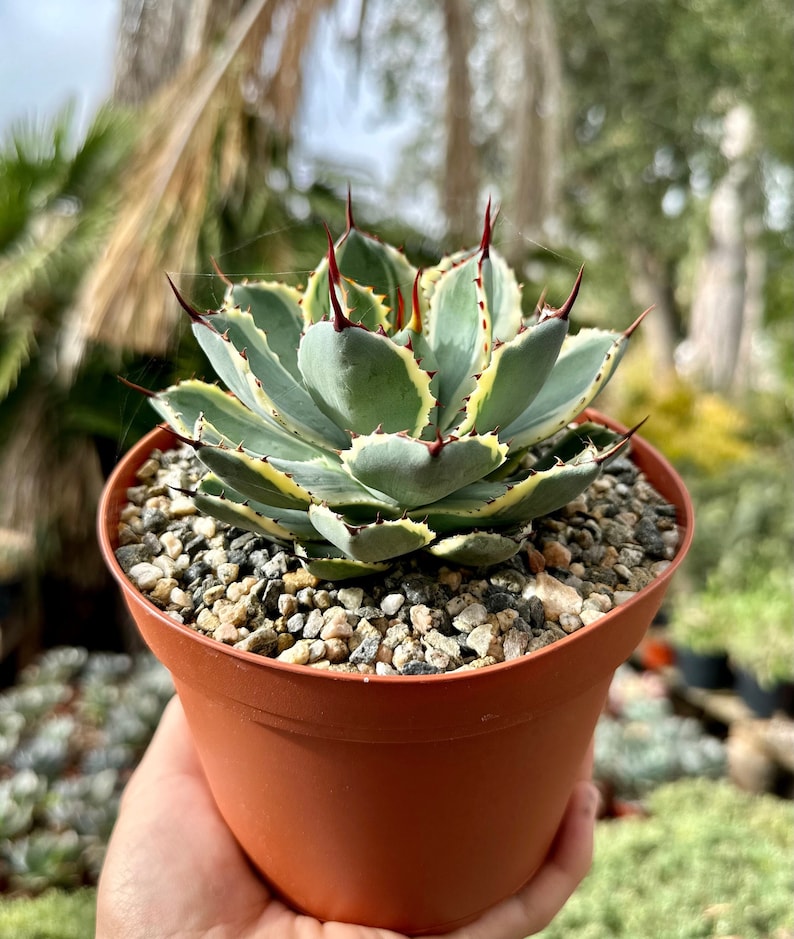
Source: Etsy
Plant Description and Size
Agave ‘Kissho Kan’ is a compact succulent that forms a rosette of fleshy, spiky leaves. The leaves are variegated, with vibrant green and creamy yellow stripes, giving the plant a distinctive and eye-catching appearance. This agave can reach a mature size of about 12 inches (30 cm) in height and width, making it an ideal choice for small gardens or container planting.

Flower Color and Blooming Period
When it comes to flowering, Agave ‘Kissho Kan’ produces tall flower stalks that can reach up to 10 feet (3 meters) in height. The flowers are a creamy yellow color and appear in early to mid-summer. It’s important to note that Agave ‘Kissho Kan’ is monocarpic, meaning that it will produce flowers and set seeds once in its lifetime before eventually dying. However, this process can take several years, as Agave ‘Kissho Kan’ is a slow-growing plant.

Care Requirements
Agave ‘Kissho Kan’ is a relatively low-maintenance succulent, making it an excellent choice for both beginners and experienced gardeners. Here are the key care requirements for this plant:
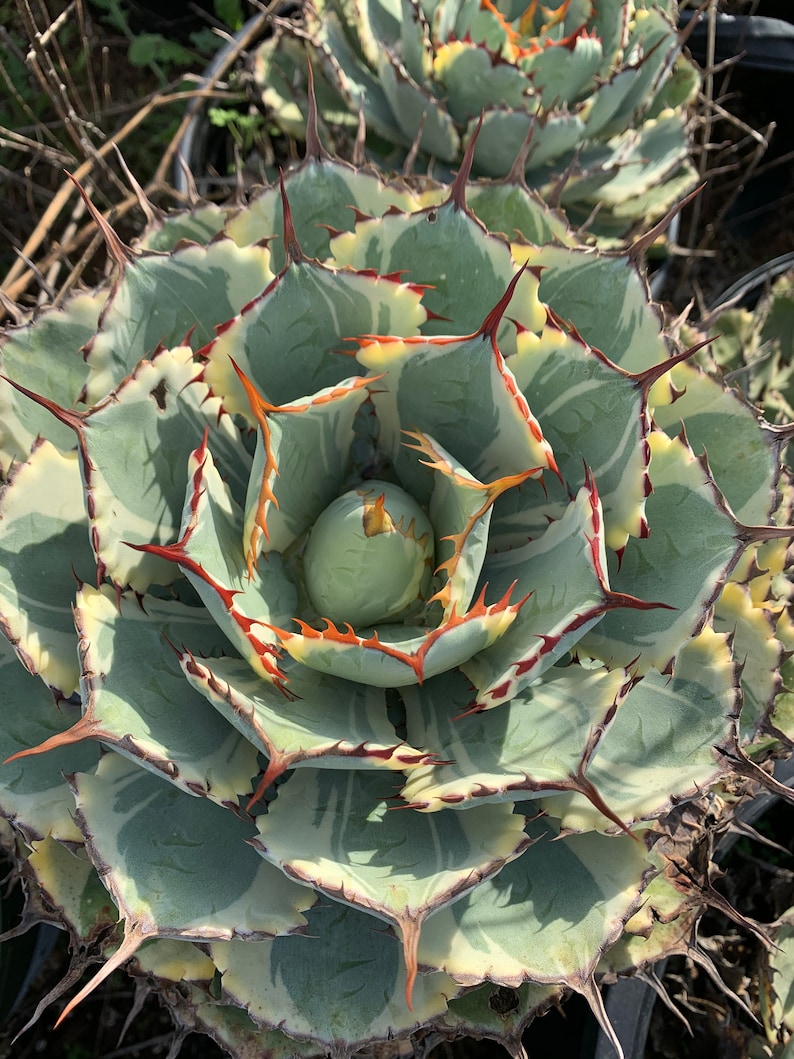
Source: Etsy
Light Requirements
Agave ‘Kissho Kan’ thrives in bright, indirect sunlight. It can tolerate some direct sunlight, especially in the morning or evening, but it’s best to avoid intense midday sun, as it can scorch the leaves. When growing indoors, place the plant near a south-facing window or provide supplemental grow lights to ensure it receives adequate light.
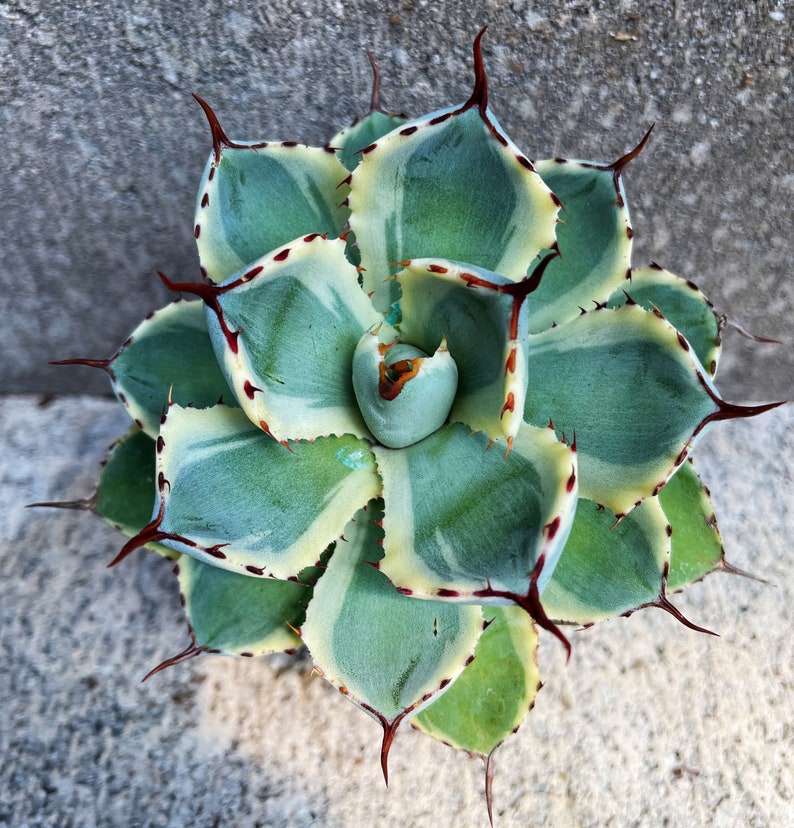
Source: Etsy
Watering
As a succulent, Agave ‘Kissho Kan’ is adapted to survive in arid conditions and is highly drought-tolerant. It’s crucial to allow the soil to dry out completely between waterings to prevent the risk of root rot. Water the plant deeply, soaking the soil thoroughly, and then allow it to dry out before watering again. During the winter months, reduce watering frequency, as the plant goes semi-dormant and requires less moisture.
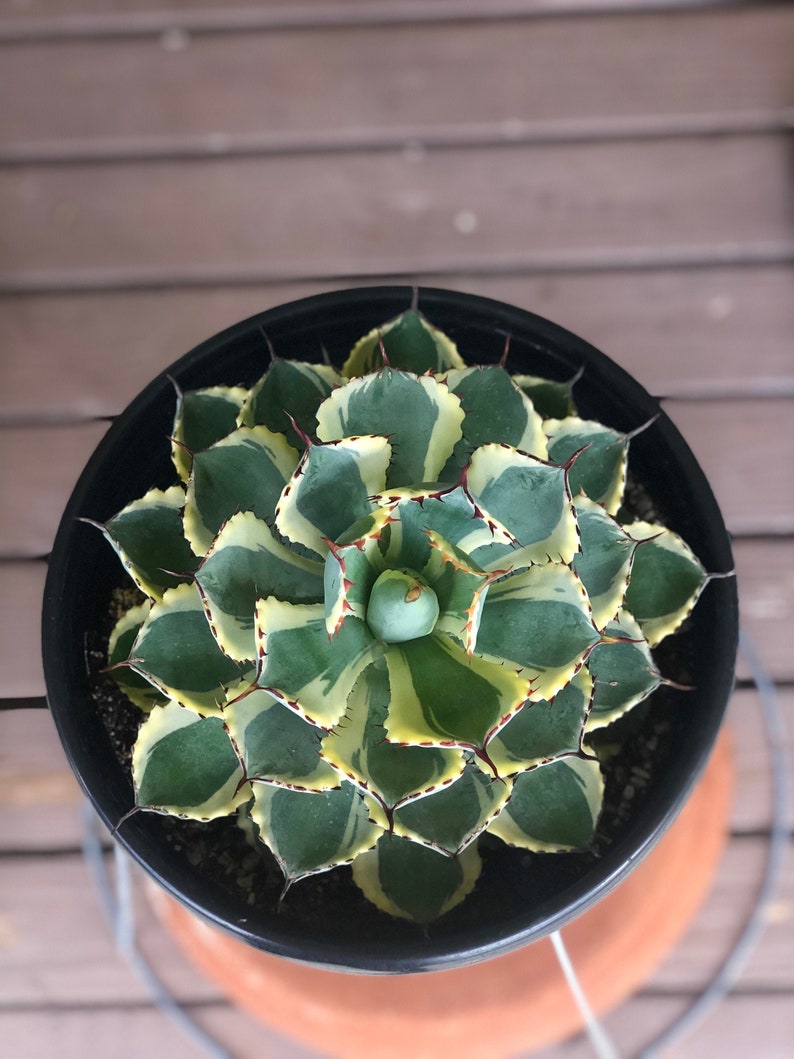
Source: Etsy
Soil Requirements
Agave ‘Kissho Kan’ prefers well-draining soil to prevent waterlogged roots. A mixture of cactus or succulent potting mix with perlite or pumice works well. This type of soil allows for proper drainage and helps prevent overwatering.

Temperature Tolerance
Agave ‘Kissho Kan’ is native to regions with warm climates and can tolerate high temperatures. It is hardy in USDA hardiness zones 9 to 11, where temperatures rarely drop below 20°F (-6°C). If you live in a cooler climate, it’s best to grow Agave ‘Kissho Kan’ in containers so that you can bring it indoors during the colder months.
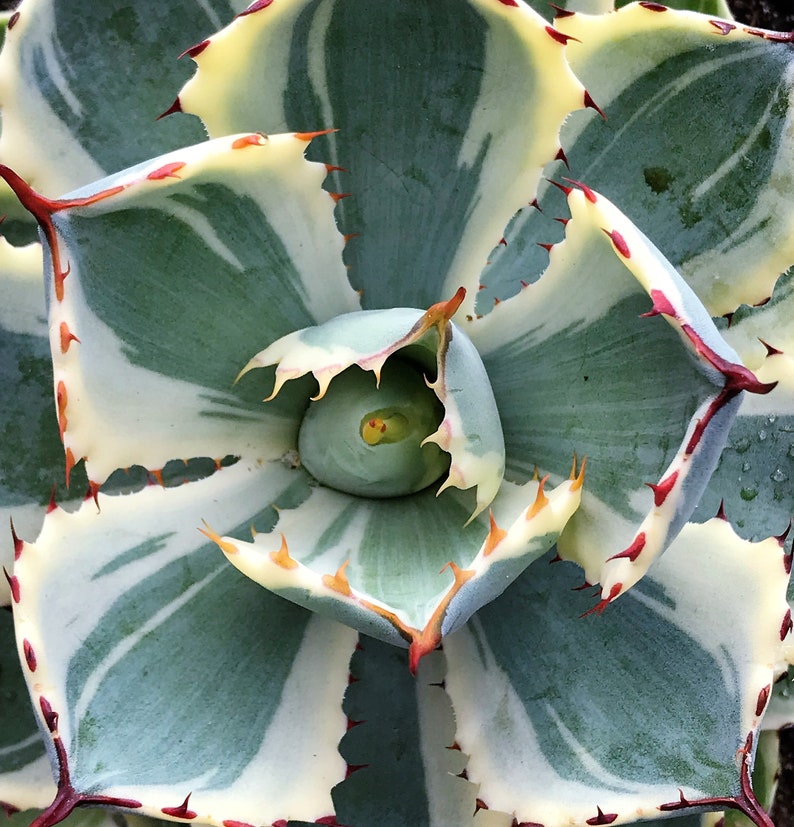
Source: Etsy
Fertilizing
Agave ‘Kissho Kan’ is a relatively low nutrient-demanding plant. A slow-release, balanced fertilizer formulated for succulents can be applied sparingly in the spring and summer months. Avoid over-fertilizing, as it can lead to excessive growth and weakens the plant.
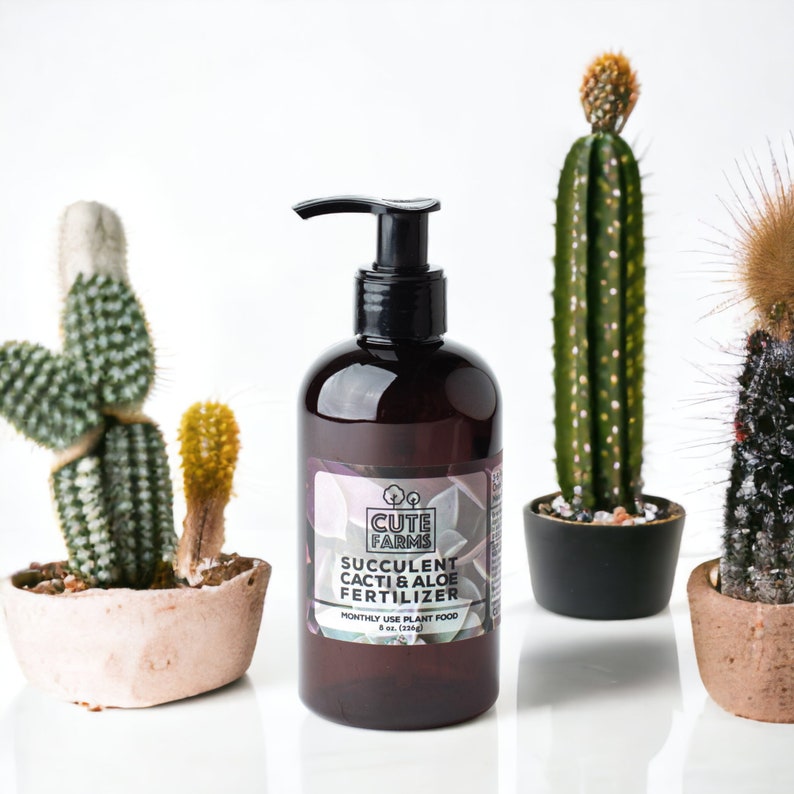
Succulent fertilizer available to purchase on Etsy.
Repotting
Agave ‘Kissho Kan’ has a slow growth rate and typically doesn’t require frequent repotting. However, if you notice that the plant has outgrown its container or the soil has become compacted, it’s time to repot. Choose a slightly larger pot with drainage holes and fresh succulent potting mix. Repotting is best done in the spring when the plant is actively growing.
When you’re rooting or transplanting your succulents and cacti, use SUPERthrive to help reduce the chance of transplant shock and grow a strong root system.
Propagation
The easiest way to propagate Agave ‘Kissho Kan’ is through offsets, also known as “pups,” that develop around the base of the plant. To propagate, carefully remove the offsets using a clean, sharp knife or scissors. Allow the cut ends to callus over for a few days before planting them in well-draining soil. Keep the soil slightly moist until the new plants establish roots.
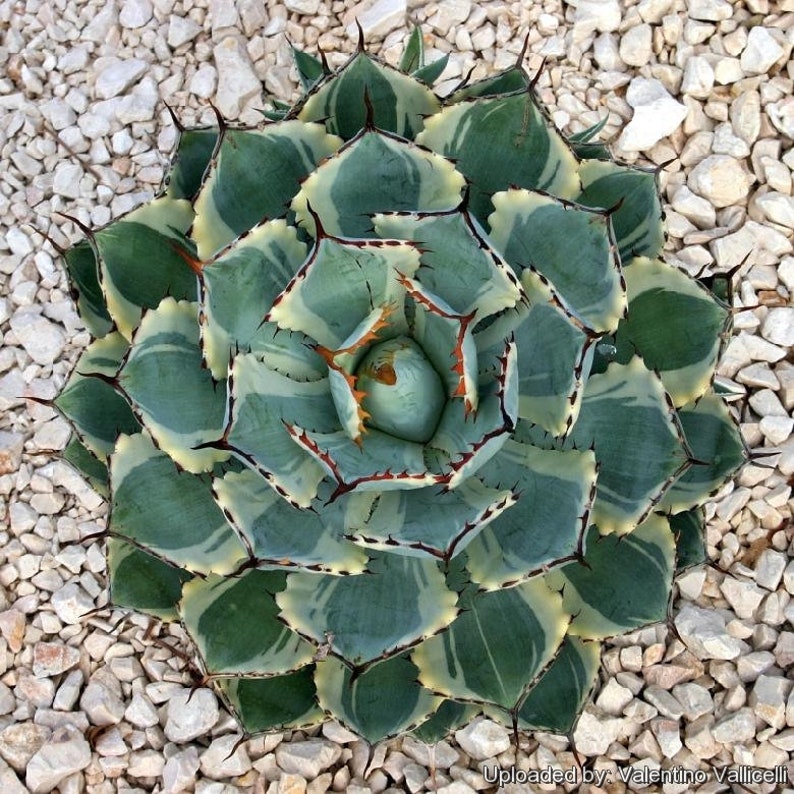
Source: Etsy
Pests and Pest Control
Agave ‘Kissho Kan’ is generally resistant to pests and diseases. However, it can occasionally attract common succulent pests such as mealybugs and spider mites. To control these pests, regularly inspect the plant for any signs of infestation, such as webbing or sticky residue. If a pest problem is detected, isolate the affected plant and treat it with an appropriate insecticidal soap or neem oil solution. Be sure to follow the instructions on the product label for safe and effective use.

As an Amazon Associate I earn from qualifying purchases.
Tips for Growing Agave ‘Kissho Kan’
Here are some additional tips to help you successfully grow Agave ‘Kissho Kan’:
- Provide adequate airflow: Good air circulation is essential for preventing fungal diseases and promoting overall plant health. Avoid overcrowding your Agave ‘Kissho Kan’ with other plants and ensure that it has enough space to grow and breathe.
- Protect from frost: While Agave ‘Kissho Kan’ is relatively hardy, it’s still important to protect it from frost and freezing temperatures. If you live in a colder climate, consider bringing your plant indoors or providing frost protection during the winter months.
- Handle with care: The leaves of Agave ‘Kissho Kan’ have sharp tips and spines, so it’s important to handle the plant with caution. Wear gloves when necessary and be mindful of the plant’s spiky nature to avoid injury.
- Monitor for signs of overwatering: Overwatering can lead to root rot and other issues for Agave ‘Kissho Kan’. Keep a close eye on the plant and watch for signs of overwatering, such as yellowing leaves or soft, mushy stems. Adjust your watering routine accordingly if necessary.
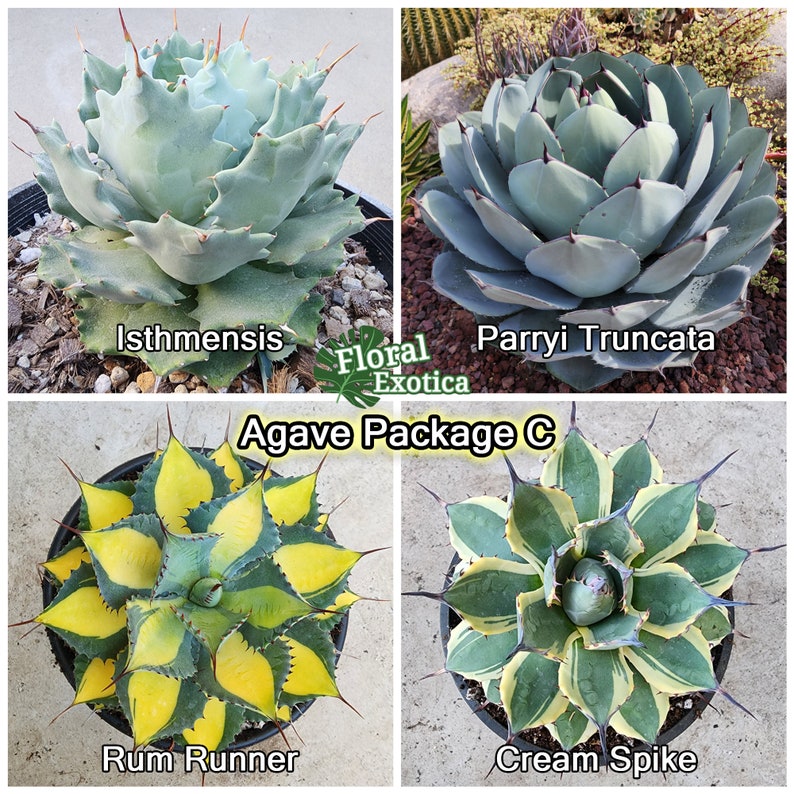
Source: Etsy
Agave ‘Kissho Kan’ is a stunning succulent that can add beauty and interest to any garden or indoor space. With its unique variegated leaves and ease of care, it’s a popular choice among succulent enthusiasts. By providing the right growing conditions, including proper lighting, well-draining soil, and careful watering, you can enjoy the beauty of Agave ‘Kissho Kan’ for years to come.

Source: Etsy
Remember to handle the plant with care, monitor for pests, and follow the recommended care practices to ensure its health and longevity. Happy gardening!

Source: Etsy


